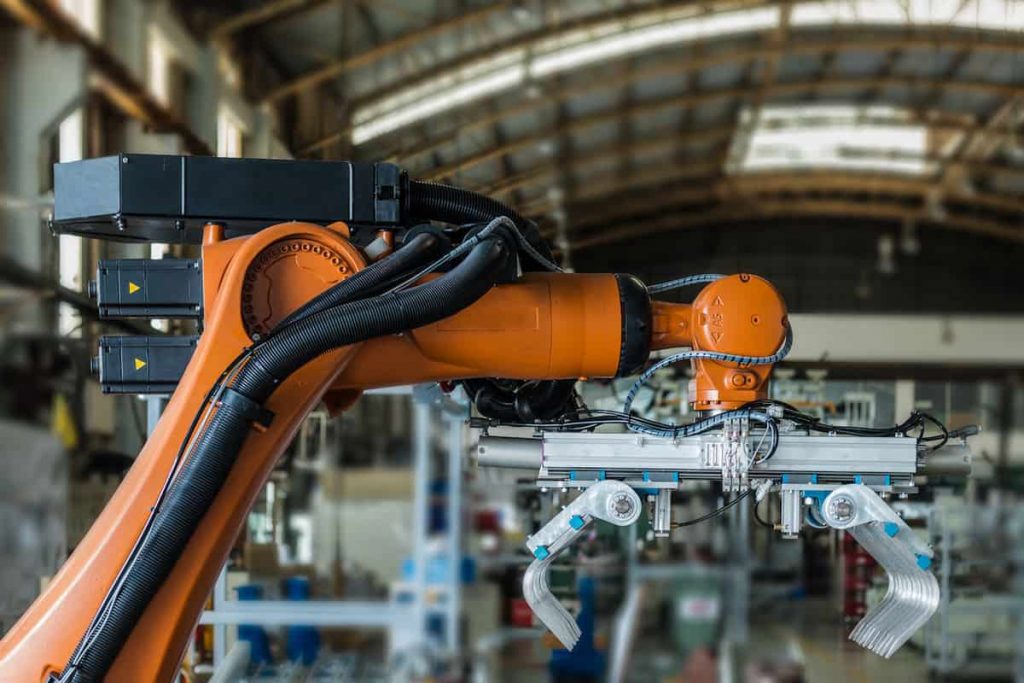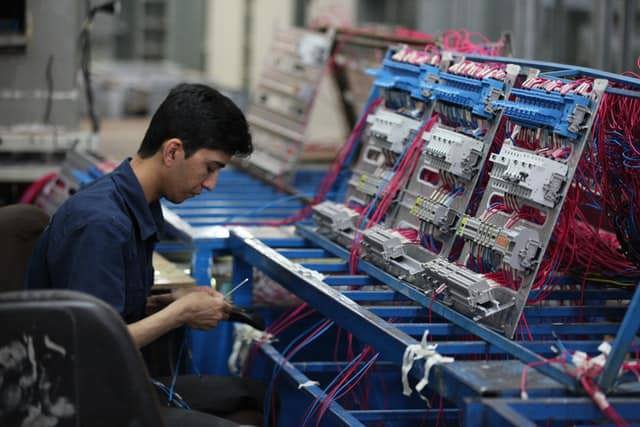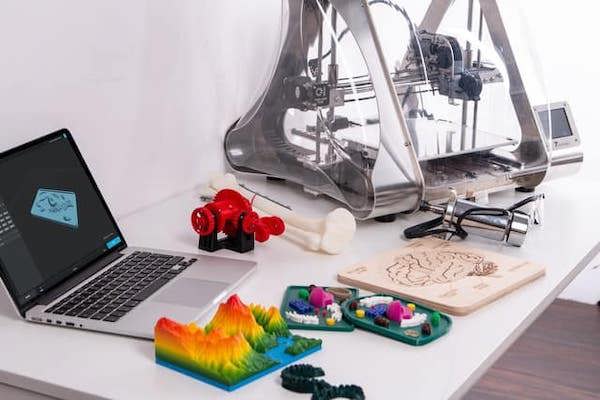
From operational intelligence to additive manufacturing, mass customisation and speed – digital manufacturing is changing the way companies manufacture products through the use of digital technologies that allow for far greater control and adaptability to the way things are conceptualised and produced.
Let’s explore some of the key aspects of digital manufacturing and how it is revolutionising the way we (and factories) work.
What is digital manufacturing?
Digital manufacturing is a key element of the Fourth Industrial Revolution and is defined as an integrated approach to manufacturing – bringing together physical machines, data and human beings to transform the manufacturing process.
What mass production and standardisation are to traditional manufacturing, mass customisation and collaboration are to digital manufacturing. It’s about companies leveraging digital technologies to assist and benefit all aspects of operations, from streamlining production to providing greater data intelligence insights that can be utilised to adapt various capabilities and outputs.
 Industry 4.0 is here to stay — how can your manufacturing business make the most of it?
Industry 4.0 is here to stay — how can your manufacturing business make the most of it?
Industry 4.0 in manufacturing
Industry 4.0 is also known as IIoT (industry Internet of Things), or smart manufacturing, and is where technology is used across both physical production and manufacturing operations. It connects products, processes and people to improve all aspects of an organisation by using software and hardware that allows for monitoring of real-time processes.
Virtually all industries today use aspects of IoT, as it provides organisations with machine learning capabilities and big data insights which can revolutionise their efficiencies, costs and quality of products and/or services. And when it comes to manufacturing, it’s no different. From understanding servicing requirements to predicting maintenance and automating different processes, its value lies in the ability to improve the overall efficiency of a manufacturing operation.
Popular IIoT technologies
Today, manufacturers use these IIoT technologies:
5G
5G is the fifth generation technology standard for cellular networks and is 100 times faster than 4G. This assists in reducing problems that are caused by ‘lagging’ technology by providing faster data transfer, and allows for increased reliability on real-time communication.
Robotics
As robots become more cost-effective, more organisations are able to benefit from their wide range of functions. Robots can be automated to take care of repetitive tasks, pick and pack in warehouses, and assemble products.
Additive manufacturing
Additive manufacturing, perhaps more commonly known as 3D printing, is where materials are added together to make a three-dimensional product. Its accessibility for all sizes of businesses has resulted in the growth of rapid prototyping (discussed in more detail below).
Predictive data
By capturing big data as it is being produced, organisations are able to benefit from the information that can assist them to be more proactive when it comes to things such as machine maintenance, product quality, consumer demand and supply chain management.
What is the Smart Factory?
The Smart Factory is a fully connected and integrated digital environment that optimises the end-to-end manufacturing process. Smart Factories use sensors, IoT, the Cloud, Big Data, AI, virtual reality, robotics and innovative production methods – like 3D printing and CNC machining.
These technologies are able to remove inefficiencies from the production line, help to reduce the cost of excess inventory and vastly improve the quality of products through real-time feedback. They can also shorten the time required to get to market as well as aid in expanding the number of products (and types of products) made.
A Smart Factory will typically have these three key attributes:
- Intelligence: Accurate, instantaneous data enables the right personnel to make highly-informed decisions. In some cases, as with AI technology, decisions are made automatically in response to data
- Innovation: Organisations are able to leverage detailed business insights, develop new processes and focus on improving business objectives, rather than being burdened by day-to-day operations
- Responsiveness: Real-time information reduces any delay in responding to issues and can enhance all aspects of productivity efficiencies
 A Smart Factory removes inefficiencies from the production line
A Smart Factory removes inefficiencies from the production line
What are the benefits of digital transformation in manufacturing?
The benefits of digital transformation in manufacturing are significant. From faster production to lower costs, closer to reality testing, real-time inventory monitoring and an ability to predict market success, companies who embrace digital manufacturing have the opportunity to be far more agile and competitive than those who still rely heavily on traditional manufacturing.
Some other benefits of digital transformation for organisations include:
- Elimination of backups through accurate material flow and assembly line processes
- Monitoring of temperatures for various cutting tools
- Testing of products and equipment to detect issues and quality of products
- Visibility of end-to-end operations for employee and management efficiencies
- Traceability of products from manufacture to the supply chain and delivery
- Manage machinery utilisation and reduce downtime with better maintenance predictability
- More accurate planning for consumer demand and responsiveness to pivot when required
- Increased innovation and collaboration opportunities
- Optimisation of equipment and work stations
- Real-time and remote monitoring of assets
- Lower cost modelling and prototype production
- Safer working environments for employees through the use of robotics and remote tasking
 Embrace digital transformation and apply it to the business correctly to avoid wasting time and resources
Embrace digital transformation and apply it to the business correctly to avoid wasting time and resources
Risks of digital transformation in manufacturing
Perhaps the greatest risk of digital transformation faces organisations who are implementing various elements of it in an established manufacturing operation. There are not only interruptions to the production process as software platforms and equipment are brought on board, but also the potential for resistance to the technologies (or at least an allowance needed for acclimation) from human resources.
With so many opportunities available for organisations, there is also a high probability of ‘analysis paralysis’ occurring, where decisions are impeded by not knowing which are the right technologies to bring onboard – ones that will improve productivity without the risk of over-complication or distraction from the core purpose of a manufacturer. And while there are a multitude of advantages for those who do embrace digital transformation, if it isn’t applied to the business correctly, the investment will be a waste of time and financial resources.
However, do the benefits of digital manufacturing outweigh the risks? We certainly think so. There’s simply no question that an organisation still using traditional methods of manufacturing will, at some stage, be left behind by those who have integrated even just some of the digital technologies available.
Cloud software and Smart Factories
Scalability and flexibility are probably the two most important aspects of ‘the Cloud’ for any industry, and for Smart Factories, Cloud software is a critical component of any operations that require IIoT and real-time data. These needs can increase and decrease depending on a variety of scenarios, and being able to change virtual infrastructure at the touch of a button allows for flexibility that cannot be matched by a physical onsite setup.
Cloud software also aids in the reduction of ‘data silos’ – ensuring transparent synchronisation of all relevant data and an essential ingredient for successful, real-time end-to-end supply chain management.
Robotics and Smart Factories
As mentioned above, robotics is one of the most popular IIoT technologies as it provides a variety of uses for a Smart Factory. In their most basic form, robotics can automate menial tasks and are able to maximise output of components or products. But in their complex form, robots can intelligently contribute to all aspects of manufacturing, driven by data and AI technology.
This is perhaps significantly more important as we move to a time where volume isn’t as crucial as it used to be – certainly not as a competitive advantage. Manufacturers want to be able to streamline processes, reduce resources and be able to customise products to meet demand. And the use of robotics is certainly one way to assist with this.
Robots can be used in many different functions – for picking and placing, feeding parts, quality control, cleaning, polishing, screwing and drilling. They can also be utilised when there are tasks that are potentially risky for humans – such as handling chemicals or lifting heavy objects.
Digital twins in manufacturing
A digital twin is pretty much what the name suggests – it is an identical replica of an object or process but represented digitally/online. However technologies such as artificial intelligence and virtual reality allow for the replica to be accurately simulated, permitting improved analysing capabilities, predictive activity tracking and predicting outcomes.
The benefits of this are largely transparent – it means organisations can scrutinise ideas and developments without the outlay and risk involved with a physical prototype, and can focus on efficiencies before determining the most preferable method and approach.
Digital twins mean manufacturers can have a more robust process when it comes to troubleshooting potential issues and can also link together complex systems in order to gain complete visual oversight that assists with decision-making.
And the possibilities are endless when it comes to the future of digital twins – from enhancing shipping protection to testing packaging materials, modelling customer behaviour and optimising logistic networks.
 3D printing can help manufacturers iterate quickly
3D printing can help manufacturers iterate quickly
Digital manufacturing and rapid prototyping
From quality to price and effectiveness, rapid prototyping has allowed many organisations to take better-designed products to market faster. Using computer-aided design (CAD) technologies, manufacturers have been able to remove the need for moulds, patterns and large numbers of tools when designing a product. And because they can rapidly produce them using additive manufacturing (3D printing), prototyping is extremely cost-effective – even when there are numerous modifications to be made and the version number makes it into triple digits.
What does digital manufacturing look like for SMEs?
Traditionally, manufacturing has been the domain of large organisations with resources to outlay substantial capital in order to set up systems and machinery. With digital manufacturing, the door is open for far more small and medium-sized enterprises to be manufacturers of bespoke products.
Mass production no longer reigns supreme. Instead, customisation and agility does, and through the use of cost-effective digital technologies, SMEs can do what they do best – specialist servicing and niche offerings. And even with a smaller workforce, SMEs are still able to provide an optimised business operation by using various technologies that can assist with better resource planning, a supply chain management system, maintaining customer relationships with a CRM, and a BI (Business Intelligence) Dashboard.
However, some challenges do present themselves to SMEs in the form of an overwhelming choice of technology to take into consideration, as well as the investment required. Not only this, but many SMEs also don’t have the luxury to ‘pause’ production while new systems are set up. It is certainly a balancing act and may be a case of focusing on business priorities first and foremost, and looking at which technology will help move the organisation towards those goals.
Examples of SME Smart Factories
Here are some examples of smaller enterprises that are doing awesome things in their Smart Factories.
Anatomics
In 2019, Anatomics, an Australia-based manufacturer of surgical products, found an abandoned car manufacturing factory in Melbourne and turned it into a 3D bioprinting warehouse. The facility houses a team of researchers as well as state-of-the-art manufacturing technology to produce craniofacial implants for reconstructive brain surgery. Digital manufacturing has allowed this organisation to innovate while reducing complexity, turnaround time and costs.
Wood Engineering Technology
Using automation, data-driven decision-making and real-time analytics which are captured by over 2000 sensors, Wood Engineering Technology (WET) in New Zealand have been able to research, develop and produce a breakthrough timber product.
Turning low-value weak wood (which was typically exported) into high-value structural strength lumber for domestic use has been the golden ticket for the company who have mastered a patented method of creating glue-laminated timber through data-driven, end-to-end automation.
The process involves examining the grade or quality of each log and then breaking it down to re-engineer it as lumber – using digital manufacturing to disassemble and then reassemble each piece with ‘glulam’, where pieces of wood are stuck together with a moisture-resistant adhesive. The result is a lighter and more flexible building material that is a sustainable alternative to concrete and steel.
Mastip
Mastip is a manufacturer of hot runners — a specialist tool used for injection moulding of plastic products. Collecting data from its factory floor has allowed them to increase the efficiency of their CNC machines. Via a dashboard on a 50-inch screen, the planning team are able to have clear visibility over which machines are suited to which jobs and check for any machines which are not running at full capacity, resulting in more informed decision-making when it comes to routing work through the factory.
By installing digital interfaces and data loggers in all machines, as well as a number of other digital manufacturing tools, Mastip has been able to measure and boost productivity.
Getting your head around digital manufacturing and the capabilities that the technology affords any organisation who wants to jump on board Industry 4.0 is certainly a bit of a head-scratcher. But the opportunities are exciting, and if you’re able to understand how and where it could fit into your manufacturing business, well – as they say – the sky’s the limit.
